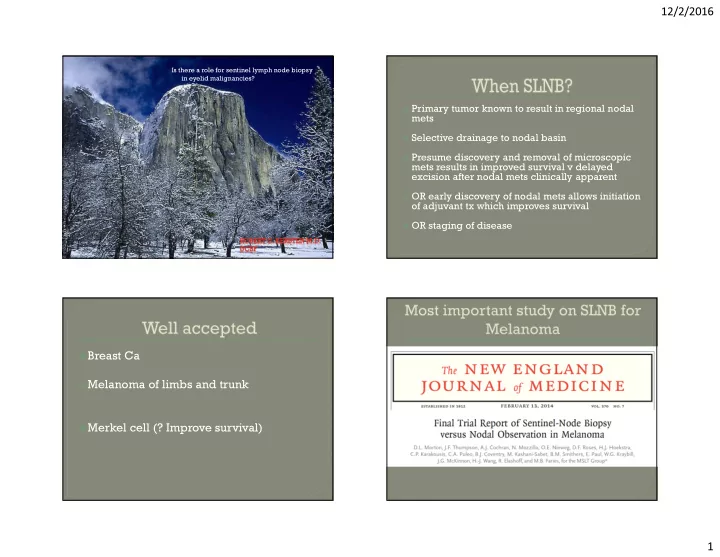

12/2/2016 Is there a role for sentinel lymph node biopsy in eyelid malignancies? � Primary tumor known to result in regional nodal mets � Selective drainage to nodal basin � Presume discovery and removal of microscopic mets results in improved survival v delayed excision after nodal mets clinically apparent � OR early discovery of nodal mets allows initiation of adjuvant tx which improves survival � OR staging of disease � Breast Ca � Melanoma of limbs and trunk � Merkel cell (? Improve survival) 1
12/2/2016 � Intermediate thickness: � Intermediate thickness (1-3.5 mm) � Randomized to SLNB and +’ve micromets: � Observation group: 17% had nodal • Melanoma specific survival 61% mets at median of 19 months � Randomized to observation and � Immediate biopsy group: 16% had developed macromets: nodal mets • Melanoma specific survival 42% (p= 0.006) � If SLNB was negative in biopsy group: 5% eventually developed nodal mets (false –’ve) � Select malignancies proclivity to develop � If SNLB –’ve, no difference in survival of nodal metastases • Melanoma SNLB (88%) v observation (86%) • Sebaceous Ca • Squamous cell Ca � No benefit melanoma specific survival • Merkel cell tumor � Lymphoscintigraphy can define nodal between the two randomized groups drainage • due to only 16-18% either group had nodal mets • Pre-auricular in large majority � Biopsy of “sentinal” nodes can identify if micrometastases present- if +’ve then perform complete nodal basin excision. 2
12/2/2016 � Does sentinal node accurately predict � SLNB itself can be performed at the time of surgical excision or ultimate nodal mets (how often false after tumor removal � Steps: negative SLNB) Inject Tc-labeled sulfur colloid near site of tumor 3 h 1. prior Remove primary 2. � Does excision of micro-metastases confer Use a gamma-probe to localize where tracer has 3. survival benefit v wait and watch for macro- accumulated Remove nodes until radioactivity is <10% of baseline in 4. mets the basin � ? Other benefits to identifying micro-mets • Prognosis � Multiple different SLNB techniques exist � Tc sulfur colloid injection +/- vital blue dye • Adjuvant tx � Only injecting vital blue dye � Using large skin incision vs. small incision for nodal removal � Using ICG dye � SPECT CT lymphoscintigraphy 3
12/2/2016 4
12/2/2016 5
12/2/2016 6
12/2/2016 � Frozen section and immediate excision � Melanoma basin if +’ve • `Skin • Conjunctiva � Sebaceous Ca vs � SCCa � Merkel Cell � Permanent section and delayed neck dissection if +’ve (esp if melanoma) � SLNB +’ve 15-21% � +’ve SLNB predicts worse prognosis • Intermediate thickness (1-4 mm) • 1 mm high risk melanomas � Removal nodal basin improves � Ulcerated locoregional control � Clark level IV � False –’ve rate 3.3-44% (mean 20.4%) � No benefit on tumor related survival � If sentinel node +’ve, additional nodes +’ve in 25% 7
12/2/2016 � No prospective / large study on impact of SLNB for eyelid melanoma � No prospective or large study � Regional lymph node metastases: 11 to 29% � Regional lymph node mets : 15% to 41% � � Based on expert opinion and many small case series, indications for SLNB � Current indications for SLNB (any one) may include (any one of the following): � ≥2mm thick � ≥ 1mm thick � Non-limbal location � Clark level ≥ IV � Histologic ulceration � > 1 mitotic figure per HPF � Histologic ulceration � SLNB +’ve: 11% to 16% Useful for prognosis � False negativity rates have decreased from 16% to But, there is no proven survival benefit to earlier detection and removal of 8% in recent years micro-metastases in head and neck melanoma � Lymphoid drainage from mucosal origin less predictable � Only small retrospective series � No prospective eyelid studies � Regional node metastasis rate: 7% to 20% � Regional nodal mets eyelids: 1.3% to 24.3% � Recommendations based on expert opinion � >10mm � Rates of regional mets from the conj: 1% � ≥ stage T2b (full thickness eyelid) � � SLNB positivity rate: 17% (2/12) to 20% (1/5) � No consensus on when to perform SLNB � Regional mets at presentation in 3.8% and did not correlate w survival in recent series of 52 cases from � Common indications (any one of the following): Bascom Palmer � >2cm in diameter � Locally recurrent � 20% reported false negatives in periocular region � Perineural invasion 8
12/2/2016 � All based on retrospective studies � Regional node metastasis from the eyelid: 21% to � Recent meta-analysis of SLNB for head 66% and neck SCC: � Most authors suggest SLNB in every case � false negative rate: 13.7% � Data on SLNB for MCC of the head and neck � Positive sentinel nodes in 20% � False-negative nodes in 12% � Only limited experience with SLNB in � SLNB positivity rate for MCC in all anatomic periocular region locations: 24% to 48% � Data from non-eyelid sites is inconclusive re impact Positivity rate: 12.5% (1/8) to 14% (1/7) on survival or recurrence rates � No reports of false-negative biopsies � � Some suggest just radiate nodal basin all cases � Sentinel nodes can be identified for � Even with –ve sentinel node, may still eyelid drainage (pre-auricular) develop nodal macrometastases � Periocular malignancies can spread to nodes • Melanoma 11-29% • Melanoma 3.3-44% (median 20%) • Sebaceous Ca 3.8%-20% • SCCa 1-24% • Sebaceous Ca 0-20% • Merkel Cell 21-66% • • SCCa 0 (head and neck 13.7%) � No evidence yet SLNB improves survival in any periocular malignancy • Merkel Cell 12% 9
12/2/2016 � “Recommendations” based on likelihood of finding a positive sentinel node � False –’ves can mislead � No evidence SLNB prolongs survival in periocular region 10
Recommend
More recommend